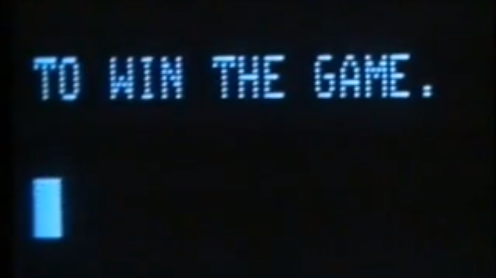
WAR GAMES (1983, Badham)
Man, I love this movie. It really holds up. This shot is more of a subtle, but very significant, moment. With War Games, the clever script and direction manage to stay on the believable side of far-fetched, no easy task. Matthew Broderick, Dabney Coleman, the hilarious Barry “I’d piss on the spark plug” Corbin are all at their prime, while nothing says 80’s flick like the adorable Ally Sheedy.
Today’s post is about a very little moment that I think has big implications. But first, here’s a cool technical side note: When making his compositions on set, director John Badham shot this film open matte, which allows for presentation in both 1.85 (the movie-theater version of our modern TV’s 16:9 rectangle) and a square 4:3 image for 1980’s TV’s. That is, he kept the lights and boom way out of frame so he could just show more above and below the rectangular movie theater composition when the film would be presented on the square, ye olde fashioned TV. He did this to avoid the horrible “pan and scan” process that wide films had to go through to fit onto the old 4:3 square TV’s. This means there are actually two different versions of the movie (much like Touch of Evil, The Shining and Empire of the Sun) – you see more in one than the other which is nominal, but somehow still great fun. (The video below is the wider 1.85/16:9 composition.)
Back to the matter at hand. This all goes back to my previous post on E.T. about the reliability and power of sound in a film and here is a very simple, subtle, but important example. (As Robert Bresson says, “A locomotive’s whistle imprints in us an entire train station.”) So many directors, particularly in television, I feel, don’t trust or value sound and feel the need to over-cover moments to death with the camera. But check out this beat in War Games which is simple, yet atypical enough to make me post about it. It’s so successful that I am sure no one even notices it at all.
Moment in question is at 1:55, but as set up: David (Broderick) connected his computer to a computer online that he thought was a game company but turned out to be military. What he thought was a game was actually the beginning of WWIII before the military shut down their mainframe. After seeing a news report of a nuclear war scare, he realizes what he did and is here trying to cover his tracks:
.
At 1:55, David (Broderick), frightened & unnerved that the computer is not only still playing the “game” but is actually phoning him, hangs up on it. But it calls back, and we learn the machine is not going to stop playing until it’s won. Now understand, the scene is all about the relentless computer stalking him via the phone lines and refusing to end the game. So the beat of the phone being hung up is an important one.
Badham’s Sound Choice
When seeing this in the theater, and even in 4:3 on old TV’s, the phone being hung up is below the frame, off camera (way off camera in 16:9 which crops top and bottom). But we hear the tell-tale sound of that action, followed by another ominous ring. That’s a super important beat and moment left OFF CAMERA. I can’t tell you how many directors and especially execs now-a-days wouldn’t have the nerve to trust the audience to understand a beat such is this without showing it. Seriously. They’d fret or get/give and sooner or later every moment that might, on the slightest outside chance, be feared missed, is shot so obviously and blatantly that before we know it, there’s nothing left to discover, nothing to figure out for ourselves, leaving us with a literal, flat presentation. With this simple moment, I’m thankful for John Badham trusted me to get a story beat through sound and my brain.
Dave Cotton
When i saw this movie at the old Avon Lake Cinema I left the theater with chest pain from all the tension built by the suspense in that flick.
Awesome.
Neat lesson today
THANKS to you!!
jsbfilm
Thanks, Dave! Sure thing. Funny, this blog is being littered with reference to those theaters. It was hopping in those days.
Jeremy Cole
Cool observation. After reading this I was watching How to Train Your Dragon with my kids. During the part where the kid, Hiccup, feeds the Night Fury a fish for the first time, he kicks his knife away. We hold on him and hear “Plunk!” as it lands in the nearby lake. Same idea. Both are more rewarding for letting your brain put the whole picture together.
I can see them putting the animatic together, having the insert of the knife falling in the water with accompanying sound effect, then realizing, “Hey, we don’t need that,” and just sliding the effect over.
jsbfilm
Great comment, as usual, Jerm. As they say, art is subtraction – there is joy in taking away to make the work stronger. Glad you had that DRAGON observation.